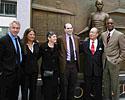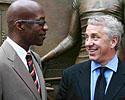
Recently on Cyclingnews.com |
News feature, May 27, 2008
A Major Monument
The story of late 19th century American track racer Marshall "Major" Taylor is well-known among cyclists, with the rags-to-riches-to-rags tale of triumph and tragedy. But thanks to a decade-long effort by passionate locals, Taylor's memory has finally been honored by the city where he lived during his rise to world fame and heartbreaking decline to poverty. Alan Coté was in Worcester, Massachusetts for the unveiling of the monument to honour the late champion.
 |
The African-American Taylor, born in 1878, set seven world record times on the track in 1898, before earning a world championship title 1899. He ranks as the second black athlete to achieve a world title (after boxer George Dixon), only a generation after slavery was abolished in the US. But the speed of Taylor's competitors was less of an obstacle for him than the oppressive racism of the times. Despite earning a substantial fortune as an international sports star, limited opportunities and unfortunate business ventures later sent Taylor's life spiraling downward. Estranged from his wife and daughter, he died in a Chicago charity ward at age 54, a forgotten and broken man buried in an unmarked grave.
Raised in Indianapolis, Indiana, Taylor moved to Worcester, Massachusetts in 1895 to escape the overt discrimination found in the Midwest. He found much more progressive thinking in this New England city, which he'd call home for the next 35 years.
Taylor's memory went unnoticed by his adopted hometown for decades. There was a downtown criterium for a few years in the early 1980s, paying tribute by borrowing Taylor's nickname, the Worcester Whirlwind, for the event. Then in the late 1990s, a group of dedicated locals formed the Major Taylor Association.
The Major Taylor Association's indefatigable efforts, spearheaded by cyclist Lynne Tolman, a staffer for The Worcester Telegram & Gazette newspaper, culminated in a glorious morning on May 21, 2008. Under blue skies, a crowd of hundreds gathered in the garden courtyard of Worcester's city library to witness sport luminaries, Taylor's descendents, Association members, and local politicians unveil an impressive bronze and granite statue.
"Courage is what makes Taylor's career so remarkable."-Greg LeMond honoured American legend Major Taylor at the unveiling of the statue. |
For Tolman, the monument and the work that went into having it created, had a deeper meaning that was brought out in a special correspondance she received. "It was really great hearing from the many people who wanted to honor Major Taylor today but couldn't make it. One that stands out is Lynne Wilson, the granddaughter of Don Walker, who was the Australian national champion in Taylor's day," Tolman explained. "She lives in Melbourne, and she sent us a congratulatory e-mail and message of international friendship.
"She didn't know her grandfather and she's not a cyclist, but she's heard the stories. That just blew my mind. Don Walker was one of the few white rivals of Taylor that was friendly to him and treated him as an equal. She's been in touch with Taylor's great-grandchilden. It bridged a gap from around the world – the legacy endures."
Dallas Brown, the sole grandson of Major Taylor, was humbled by the work that had been done to remember his grandfather. "This is difficult for me. I've given hundreds of talks and briefings in my military career. But this is very different. I feel some embarrassment being here, as it is essentially reflected glory," admitted the 75-year-old retired Army General. "I have done essentially nothing to enhance my grandfather's legacy. But Lynne Tolman and the city of Worcester have done so much.
 |
"I do understand some things about my grandfather. His determination. His character. He was a religious man, with deeply held beliefs about things like not racing on Sunday, no alcohol, tobacco, or swearing. And he had a forgiving spirit towards his enemies and adversaries."
Three-time Tour de France champion Greg LeMond was on hand to pay tribute to Taylor. "When I was 16 years old I felt so out of place, only coming from the west coast to the east coast to race," said LeMond. "And I also know what it feels like to be a target as a competitor. So I imagine Taylor at a young age of 17 or 18, racing in Indiana, against all white racers ... and dominating, pulling all this attention to himself. He had physical threats, political threats, and backhanded deals against him."
"Courage is what makes Taylor's career so remarkable. I hope this statue can be a symbol of courage and hope. I think we've come a long way in the last 100 years – we may have the first black man as president – and yes I'm voting for Obama. I do hope it inspires others to overcome and not think about others by race or color."
 |
Three-time Olympic track and field medallist Edwin Moses underscored the importance of remembering a hero like Taylor. "Nelson Mandela came to our organization's (Laureus World Sports Academy) initial event. He said that sport has the power to change the world, it can give hope where there once was despair. Today is a day for hope. The Major Taylor story is very, very important – if we don't understand the history of what he went through, then it's bound to repeat itself."
"Taylor was the first African-American international sports star. We know the trial and tribulations of others who suffered from discrimination," Moses continued. "Arthur Ashe in the 1970s, Jackie Robinson in 1947, Tommie Smith in the 1968 Olympics, Muhammad Ali in the 60s and 70s, Henry Aaron in 1974, Jack Johnson in the 1920s, Jesse Owens in 1936. Today we're recognizing someone missing from this list. After today Marshall Major Taylor will take his rightful spot at the top of this distinguished list after more than 100 years."
 |
Track sprinter Nelson Vails, a silver medallist in the 1984 Olympics, compared his experience with what Taylor endured. "It's tremendous honor to be here. In my racing days I was aware of Taylor, but I was in a different world, the zone of my own racing," said Vails. "But in my later years I came to appreciate Taylor's accomplishments. Unlike Taylor, I did not have to overcome racial barriers to succeed in modern day racing through the 1980s and 1990s. I raced in Australia, in Paris, and following in those footsteps (of Taylor) was a tremendous honor."
"Taylor was someone I had huge respect for through my cycling career. He broke the color barrier, as a course of survival," said John Howard, a multi-time Olympic cyclist and 1981 Hawaii Ironman Triathlon Champion. "It was not a safe time for a black athlete. But there are things about Taylor that many people don't know, like he was an inventor. He came up with an idea for a unique wheel and other bike components like the outrigger stem. He was a pioneer not only as a cyclist but as an engineer."
Saving Taylor's Relics
With the Worcester statue, along with a recent book (Major: A Black Athlete, a White Era, and the Fight to Be the World's Fastest Human Being by Todd Balf), interest in Taylor has never been higher – at least since the sprinter himself dominated on the world's velodromes over a century ago. But things were quite different not long ago, like during the dark ages for bicycle racing in America in the 1960s.
My father, Joseph Cote, born in 1922, began racing bikes in his hometown of Worcester at the height of the depression. Many of the "old-timers" of the era had known Taylor, and one, former pro track rider Walter Greenquist, born in 1890, had purchased two of Taylor's Peugeot bicycles when the former world champion fell on hard times. When Greenquist passed away in 1965, his daughter called my father to ask for help in selling the old bikes stashed away in the family's lake camp (summer cottage).
The two Peugeots – which could easily have ended-up in the town dump – were recognized by my father among the other vintage bikes. He sold one, and bought the other for himself. Later my Dad donated Taylor's bike to the US Bicycling Hall of Fame, which it now houses in its collection.
Also in the 1960s, through my father's job he met a salesman for Commonwealth Press, a Worcester print shop – the company that produced Taylor's self-published autobiography The Fastest Bicycle Rider in the World. Still in the shop were two dozen un-circulated copies of the book (complete with paper dust jackets), which presumably Taylor had been unable to pay for. Amazingly, the leftovers had been sitting for almost 40 years. The printer gladly sold the books to my Dad for a few dollars each. My Dad dispersed most the books over years – the coveted hardbacks now command several hundred dollars each among collectors.
– Alan Coté
Photography
For a thumbnail gallery of these images, click here
Images by Alan Cote
- Backside of the Taylor statue
- Dignitaries in front of the statue , as sculptor Antonio Tobias Mendez speaks from the podium
- Greg LeMond & Edwin Moses chat in front of the statue
- LeMond helping unveil the statue
- Moses snaps a photo for himself of the statue.
- Nelson Vails and sculptor Antonio Mendez
